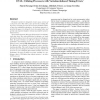Free Online Productivity Tools
i2Speak
i2Symbol
i2OCR
iTex2Img
iWeb2Print
iWeb2Shot
i2Type
iPdf2Split
iPdf2Merge
i2Bopomofo
i2Arabic
i2Style
i2Image
i2PDF
iLatex2Rtf
Sci2ools
MICRO
2008
IEEE
2008
IEEE
EVAL: Utilizing processors with variation-induced timing errors
Parameter variation in integrated circuits causes sections of a chip to be slower than others. If, to prevent any resulting timing errors, we design processors for worst-case parameter values, we may lose substantial performance. An alternate approach explored in this paper is to design for closer to nominal values, and provide some transistor budget to tolerate unavoidable variationinduced errors. To assess this approach, this paper first presents a novel framework that shows how microarchitecture techniques can trade off variation-induced errors for power and processor frequency. Then, the paper introduces an effective technique to maximize performance and minimize power in the presence of variationinduced errors, namely High-Dimensional dynamic adaptation. For efficiency, the technique is implemented using a machinelearning algorithm. The results show that our best configuration increases processor frequency by 56% on average, allowing the processor to cycle 21% faster than with...
Hardware | MICRO 2008 | Processor Frequency | Unavoidable Variationinduced Errors | Worst-case Parameter Values |
| Added | 31 May 2010 |
| Updated | 31 May 2010 |
| Type | Conference |
| Year | 2008 |
| Where | MICRO |
| Authors | Smruti R. Sarangi, Brian Greskamp, Abhishek Tiwari, Josep Torrellas |
Comments (0)

